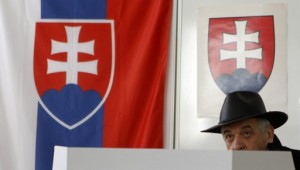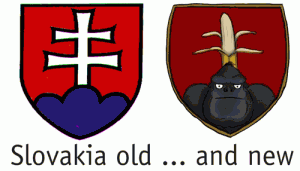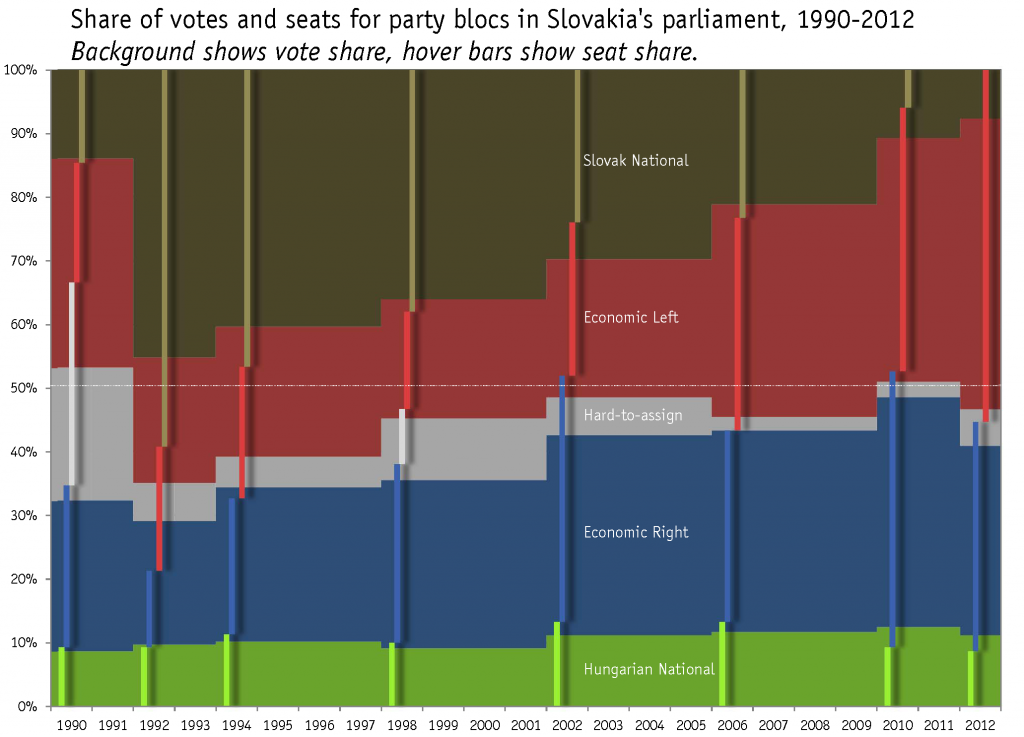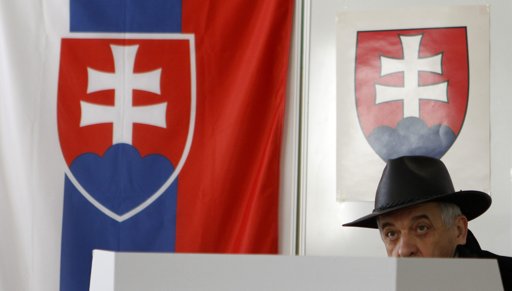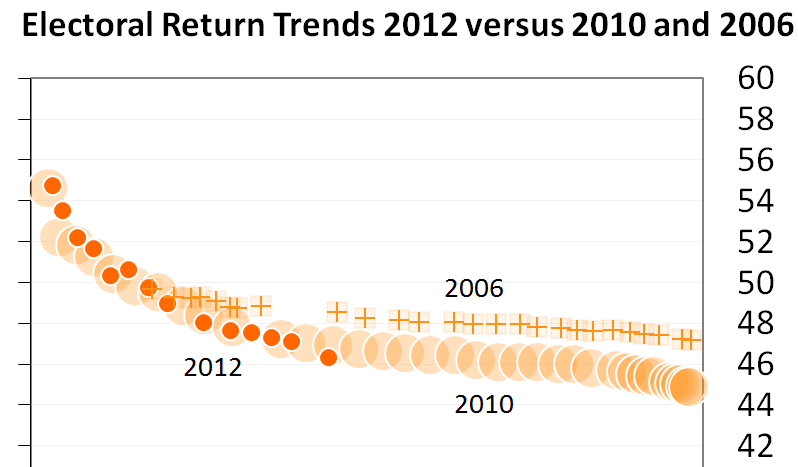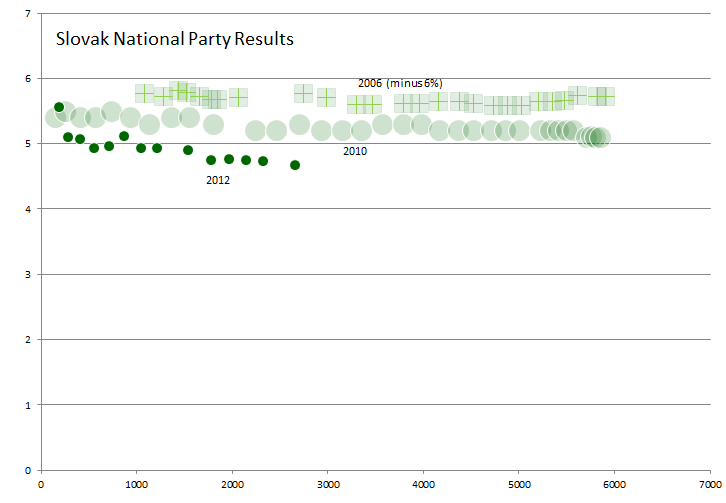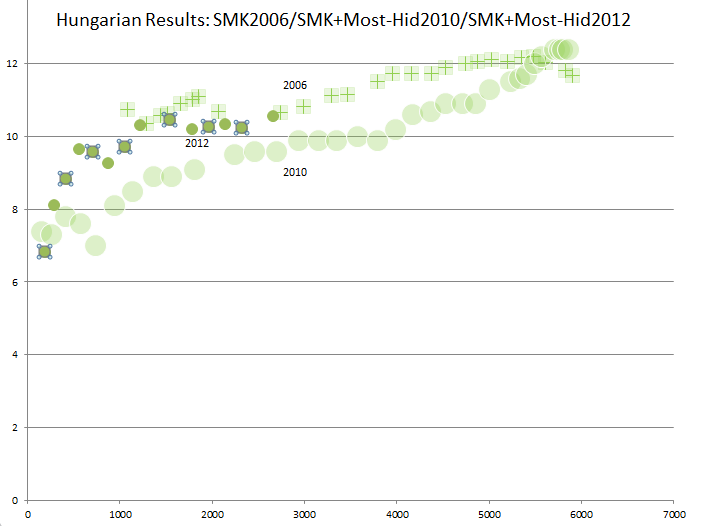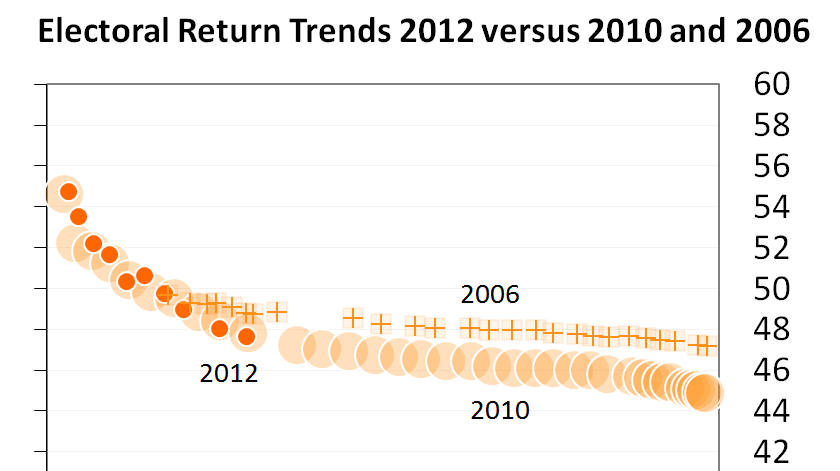Just a note 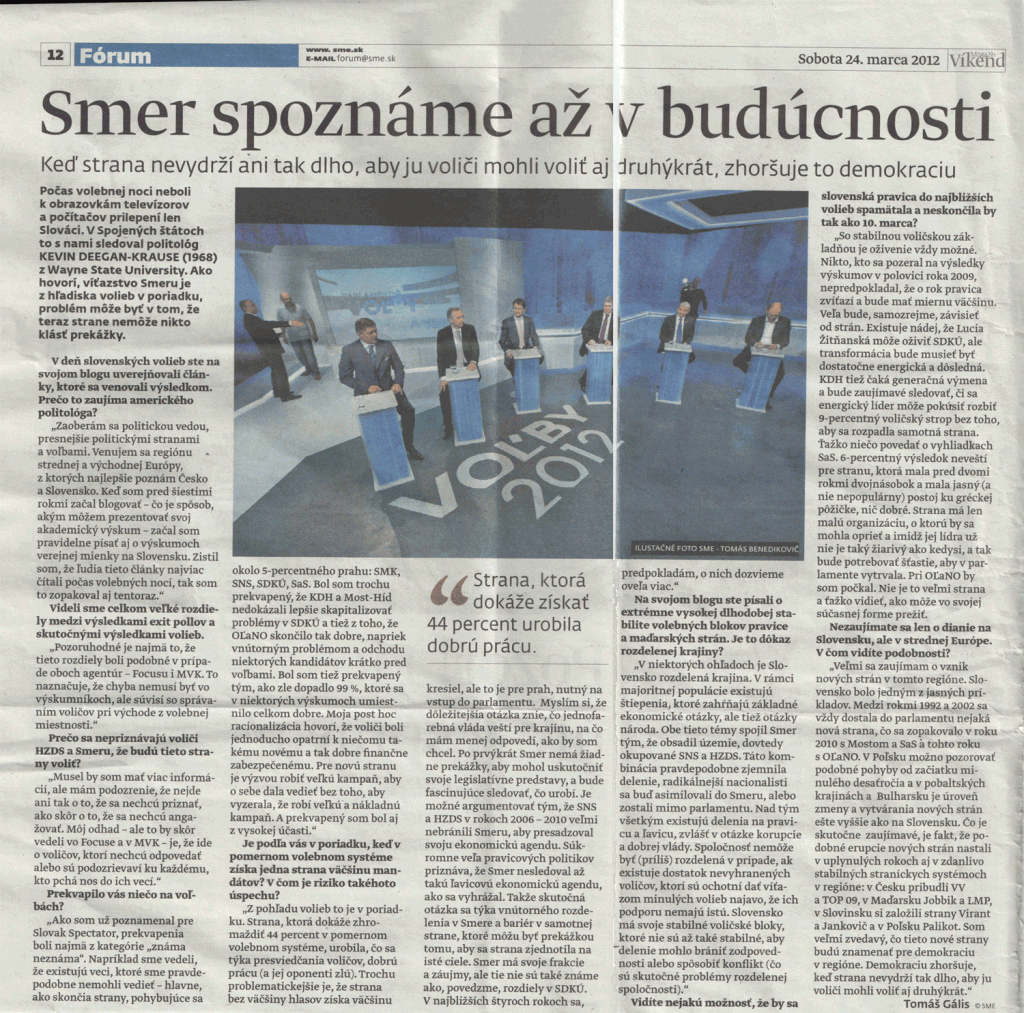 to post the interview that recently appeared in SME (with thanks to Tomas Galas for good questions and good translation). The original interview is here (but limited to PIANO users): http://komentare.sme.sk/c/6311867/o-zaujmoch-smeru-sa-dozvieme-az-v-najblizsich-rokoch.html
to post the interview that recently appeared in SME (with thanks to Tomas Galas for good questions and good translation). The original interview is here (but limited to PIANO users): http://komentare.sme.sk/c/6311867/o-zaujmoch-smeru-sa-dozvieme-az-v-najblizsich-rokoch.html
I’ve inserted the text of the full English translation below in text and along with quite a few questions that did not make it into the print version. There was also a recent Slovak Spectator interview, in English, here: http://spectator.sme.sk/articles/view/45744/2/no_easy_read_on_what_fico_wants.html
SME,24 March 2012, Vikend, pp. 12-13.
V deň slovenských volieb ste na svojom blogu uverejňovali články, ktoré sa venovali exit pollom a výsledkom volieb. Prečo?
You were writing about exit polls and official results during Slovak election. Why?
My profession is political science–I teach at Wayne State University in Detroit, Michigan, USA–and the thematic focus of my work is political parties and elections. My regional focus is Central and Eastern Europe and the countries I know best are Slovakia and the Czech Republic. I have spent more than twenty years studying those two countries and 4 total years living and working there, especially in Bratislava and have developed a deep affection for them. When I return to Slovakia, I feel in some way as if I am returning home. It is therefore utterly natural to me to pay attention to Slovakia’s politics, and when I began to blog 6 years ago as a way to communicate the results of my academic research, I began to blog regularly on public opinion polling in Slovakia. I found that readers were most interested on election nights and so I began to live-blog on those nights (and since Slovakia’s polls close at 4pm my time (rather than 10pm Slovakia time) I do not have to stay up /all/ night :-)
Videli sme celkom veľké rozdiely medzi výsledkami exit pollov a skutočnými výsledkami volieb. Máte na to vysvetlenie?
The differences between exit polls and official results of the election were quite significant. Can you explain it?
I have not been party of the exit polling or seen the raw data, so this is difficult for me to judge, but in the past two election cycles we have seen big differences between these polls and the actual results and for at least the last two cycles these differences have pointed in the same direction. It is noteworthy to me that the differences were similar for both FOCUS and MVK polls in both years suggesting that it is not something pollsters are doing wrong but that relates to the behavior of voters on exit.
Prečo sa nepriznávajú voliči HZDS a Smeru, že budú tieto strany voliť?
Why people, who are voting for Smer (and for HZDS), don´t admit it when they are asked by an interviewer?
I would need to see more information on this, but I would suspect that it may not be a refusal to admit but rather a refusal to engage. My guess–but you should confirm this with FOCUS and MVK–is that these are the voters who cannot be bothered to answer or who are suspicious of anybody prying into their business. Why this should be more likely among Smer voters is not clear, but it is notable that there have been relatively difficult relationships between pollsters and political parties in the past–difficulties capitalized upon by HZDS in the mid-1990’s. As the HZDS electorate (and family members) have migrated to Smer, it is possible that these feelings have moved as well. At the same time, it is noteworthy that the patterns are not wholly consistent.
Aký je váš názor na výsledky volieb? Prekvapilo vás niečo?
What do you think about results? Were you surprised?
As I noted to the Slovak Spectator, the surprises were mostly in the “known unknown” category—i.e. we knew there were things we probably could not know, especially the performance of parties very close to the 5% threshold: SMK, SNS, SDKU, SaS. I was a bit surprised that KDH and Most-Hid could not capitalize better on the problems within SDKU, and also that OLaNO did as well as it did despite the internal difficulties and departure of candidates fairly near the election (though given the heterogeneous composition of the party, that kind of conflict was not actually a surprise). I was also surprised at how poorly 99% did after a strong showing in some polls, but my post hoc rationalization says that voters were simply wary of something that new and that well-resourced. The challenge for a new party is to run a big campaign to make yourself known without looking like you are running a big and expensive campaign.
I was also surprised by the turnout which I expected to drop in the light of the Gorilla scandals and other disillusionment, but perhaps I should not be. Turnout rates dropped through the 1990’s and much of the 2000’s but turnout decline at every level has seemed to stop in the mid-2000’s and has stabilized. Still, I thought this turnout would be lower than normal and I’m keen to learn from Slovak experts why it didn’t.
Je podľa vás v poriadku, keď v pomernom volebnom systéme získa jedna strana väčšinu mandátov? V čom je riziko takéhoto úspechu?
Is it OK, when a single party wins majority of mandates in a proportional voting system? Where is a risk of such success?
It is certainly v poriadku from an electoral perspective. A party that can muster 44% in a proportional system has certainly done a good job persuading voters (or has seen its opponents do a particularly poor job). It is slightly more problematic that a party without a majority of /votes/. Can win a majority of seats, but this is the consequence of electoral thresholds and parties that make it almost but not quite over those thresholds, producing a large number of votes that do not receive seats. Slovakia in 2012 had its second highest recorded share of votes going to parties that did not, in the end, get seats. That is in part because of the almost-but-not-quite performance of SNS and SMK, but also because of the emergence of a significant number of smaller parties getting small shares of the vote. It is also worth noting that the Smer majority in parliament would have been much smaller if either SMK or SNS had made it over the threshold (a question of a mere 10,000-20,000 votes) and if both had made it over the threshold, there would have been no Smer majority at all (only 73 or 74 seats).
The bigger question, I think, is what a single party government portends for the country and on that I have fewer answers than I wish I did. For the first time there are no barriers to Smer accomplishing its legislative agenda and it will be fascinating to see what it does. That said, I think it’s possible to argue that SNS and HZDS did not pose much of a barrier to Smer’s economic agenda in 2006-2010, and yet even many politicians of the right privately admitted that the party had not pursued as “left-wing” an economic agenda they had feared. So the real question to me is about the internal divisions within Smer and the kinds of barriers within the party that might prevent it from being unified around certain goals. But those are quite “closed door” questions and so an observer from abroad (and even an observer at home in Slovakia) may have difficulty figuring that out. Smer has its factions and interests, but they are not nearly as well known as, say, divisions within SDKU. Over the next four years, however, I suspect we will find out a lot more.
Na svojom blogu písali o extrémne vysokej dlhodobej stabilite volebných blokov pravice a maďarských strán. Je to dôkaz rozdelenej krajiny?
You wrote about extremely high degree of long-term stability of bloc-voting levels of Slovakia´s right and among the Hungarian national parties. Is it a proof , that Slovakia is a divided country?
Slovakia is in some ways a divided country but not unsustainably so. One of its two significant ethnic groups has its own strong set of attitudes and political parties, and so this creates a 90:10 split (really about 88:12) that is pretty natural and not at all unusual for the region. And these parties have not been consistently excluded from government, which helps to maintain a certain level of cooperation. Within Slovakia’s majority population, there are splits that involve basic questions of economics on the one hand and questions about the importance of nationality on the other. We’ve seen these two dimensions come into alignment of late as Smer has taken over some of the territory once occupied by SNS and HZDS, but the combination has probably actually softened the division a bit as more radical nationalists are either assimilated into Smer or left outside parliament. And above it all, there are some cross cutting divisions between left and right, especially the question of corruption and good government. SaS benefitted from some dissatisfaction with corruption in the Smer government in 2010 and Smer probably benefitted from some dissatisfaction with the shady dealings of SDKU and SaS. A society cannot be /too/ divided if there are enough swing voters to let the incumbents know that they cannot take popular support for granted. Slovakia has its stable blocs but not /so/ stable that the divisions can prevent accountability or cause conflict (which are the real problems with societal division)
Na svojom blogu písali o extrémne vysokej dlhodobej stabilite volebných blokov pravice a maďarských strán. Je to dôkaz rozdelenej krajiny?
You wrote about extremely high degree of long-term stability of bloc-voting levels of Slovakia´s right and among the Hungarian national parties. Is it a proof , that Slovakia is a divided country?
Slovakia is in some ways a divided country but not unsustainably so. One of its two significant ethnic groups has its own strong set of attitudes and political parties, and so this creates a 90:10 split (really about 88:12) that is pretty natural and not at all unusual for the region. And these parties have not been consistently excluded from government, which helps to maintain a certain level of cooperation. Within Slovakia’s majority population, there are splits that involve basic questions of economics on the one hand and questions about the importance of nationality on the other. We’ve seen these two dimensions come into alignment of late as Smer has taken over some of the territory once occupied by SNS and HZDS, but the combination has probably actually softened the division a bit as more radical nationalists are either assimilated into Smer or left outside parliament. And above it all, there are some cross cutting divisions between left and right, especially the question of corruption and good government. SaS benefitted from some dissatisfaction with corruption in the Smer government in 2010 and Smer probably benefitted from some dissatisfaction with the shady dealings of SDKU and SaS. A society cannot be /too/ divided if there are enough swing voters to let the incumbents know that they cannot take popular support for granted. Slovakia has its stable blocs but not /so/ stable that the divisions can prevent accountability or cause conflict (which are the real problems with societal division)
Vidíte nejakú možnosť, že by sa slovenská pravica do najbližších volieb spamätala a neskončila by tak ako 10. marca?
Do you see a chance that right-wing parties will recover till next election and succeed better than in previous one?
With a stable voting base, recovery is always an issue. Nobody who looked at polling results in mid-2009 would have been likely to predict an electoral victory on the right in 2010 and yet the parties of the right managed a slim majority. A lot will depend on the parties, of course. There is some hope that Zitnanska can revitalize the SDKU, and that would certainly help, but I think the transformation will need to be quite energetic and thorough. KDH is also seeing generational change in its leadership, and it has some energetic leadership, though it will be interesting to see if an energetic leader can try break through the party’s 9% electoral ceiling without in the process breaking the party itself. Elsewhere on the right it is hard to know what to make of the prospects for SaS. A 6% result does not bode well for a party that started two years ago at 12% and that had a clear (and not unpopular) stance on the Greek bailout. The party has little organization to fall back on and its leader’s image is not as shiny as it once was and so it will need to get lucky to stay in parliament, either by recovering OL voters or being shown to be right on Greece. As for OLaNO, I wait with some anticipation. There is not much party there, and it is hard to see how it can survive for long in its present form.
Zaujímate sa o dianie nielen na Slovensku, ale v strednej Európe. V čom vidíte podobnosti a rozdiely našej krajiny oproti okolitým štátom?
You are interested not only in Slovakia, but in Central Europe as a whole. Do you see some similarities and differences between Slovakia and neighbouring countries?
I am extremely interested these days in the emergence of new parties throughout the region. For a time, Slovakia was one of the most obvious cases that something different was going on: Slovakia produced one or two major new parliamentary parties in every election between 1992 and 2002 and then again with SaS and Most-Hid in 2010 and SaS in 2012. Poland had some of the same significant shifts through the early 2000’s and the Baltics and Bulgaria have seen levels of change and new-party creation that are even higher than in Slovakia. But what is really interesting is that in the last two years other seemingly stable party systems in the region have seen similar “new party eruptions”: VV and TOP09 in the Czech Republic, Jobbik and LMP in Hungary, Virant and Jankovic in Slovenia (and just recently Polikot in Poland). I am extremely curious what these new parties mean for democracy in the region and it impairs democracy when parties do not last long enough for voters to vote for them a second time. I am also really interested in the way that Smer stands out from this group. As a new party with a strong anti-corruption appeal in the early 2000’s, it should have died like the others but it has instead gone from strength to strength. Its survival may have depend on the fact that it did not go immediately into government in 2002 but had time to wait, strengthen itself and find an ideological profile on the left (no longer “the third way”) that let it provide a strong alternative to the neoliberals of the second Dzurinda government.
Not in the print interview:
Myslíte si, že nacionalisticky orientovaný volič ešte niekedy dá svoju dôveru SNS alebo strana už nezíska stratené hlasy?
Do you think, that nationalist voters will ever vote for SNS or SNS will never get lost voters?
What happens on the Slovak national side of the electorate will be extremely interesting. The voting for parties in this segment of the population has dropped significantly over time, but I do not see much evidence that passion about the Slovak nation has declined for many voters, so it reflects not so much a shift in attitudes as a shift in where people with those attitudes decide to cast their ballots. We have seen a significant shift away from HZDS and now from SNS, mostly to Smer. One question is whether Smer can–or even wants to–give those voters what they want. If it can, it may keep those voters from returning to SNS (though it may keep them by the kinds of actions that risk losing other voters who do not like strong national feelings). The other question is whether SNS can adapt and change. As Marek Rybar of Comenius University has pointed out, SNS has the most leader-centered stanovy of any party in Slovakia, and the current leader has some liabilities. If he is willing to relinquish control, the party may have a chance to recover (it will still receive state funding because it got above 3%), but an SNS that continues to be controlled by Slota will have to be uncharacteristically skillful to avoid the result we saw after Meciar’s HZDS dropped out of parliament and simply disappeared from the political radar screen.
V Česku prebieha ďalšia vlna protestov proti vláde a „starým“ politikom. Pred mesiacom to bolo aj u nás. Napriek tomu si ľudia týchto politikov volia znova a znova. Prečo?
There is another wave of protests against government and „old“ politicians in Czech republic. There were similar protests one month ago in Slovakia too. But people are still voting for these „old“ politicians. Why?
Well they did vote for “not old” politicians in significant numbers. The results for OLaNO, 99%, SSS and some other smaller parties was quite high and Slovakia continues to generate new parties in every election (2006 was the only exception so far). The problem is that voting requires not just saying “no” to the old but saying “yes” to something else. In the Czech Republic in 2010 there were two strong “new” options that people could (at the time) feel good about choosing as a way of saying “No.” Slovakia saw much the same with SaS (and Hungary with Jobbik and LMP, and Slovenia with Jankovic and Virant, and Poland, to a lesser extent with Polikot). But in 2012 the “yes to the new” options were somewhat scarcer: Matovic and OL were already a known and somewhat tarnished good, and 99% simply seemed too artificial (and lacked a single strong voice like Matovic or John or Schwarzenberg). But this does not mean that another option isn’t out there. Of course it’s not at all clear that it is a god thing to vote for the “new” without better understanding of what the new is. The Czech example of VV–an “anti-corruption” party owned by a businessman who seems to have created it to make it easier to engage in corruption–points to the problem. The other problem is the apparent inability of many parties in Central Europe to renew themselves. It will be interesting to see what happens with Zitnanska at the helm of SDKU, but on election night five of the six parties in Slovakia’s parliament were headed by their founding leader: Fico, Sulik, Dzurinda, Matovic, Bugar. Only KDH has had significant leadership changes, and it has had a remarkably stable support over time. (It is noteworthy to me that SMK, another party with the possibility of leadership change, managed to sustain considerable support despite being out of parliament.) If parties cannot renew themselves–if they are leader-driven vehicles, then new parties are more likely to emerge to challenge them when the leader becomes tainted and taints the party.
Prečo sa, ako Američan, vôbec zaujímate o slovenskú politiku?
Why are you, as an American, interested in Slovak politics?
In a sense my interest in Slovak politics began accidentally. I was one of the wave of American teachers of English who crowded Czechoslovakia in 1990 in search of adventure and excellent beer (and in my case a fascination with Vaclav Havel), but I was lucker than most to the extent that my post-teaching work in graduate school forced me not only to pay attention to Prague (which I still love) but also to Bratislava (which feels like /home/) and gave me a broader sense of the region. And Slovakia has many times over repaid my interest. Not only have I developed deep friendships with Slovaks, but I have also come to understand ways of thinking that were at first new to me–the idea of “narod” was not something that I could grasp theoretically but had to experience directly. And as this last election continues to show, Slovakia’s politics is never uninteresting.
Je medzi študentmi vašej univerzity záujem o dianie v strednej a východnej Európe?
Are students from your university interested in Central and Eastern Europe?
The inhabitants of Detroit include a very large number of immigrants and quite a few from Central and Eastern Europe. Many of the children and grandchildren of those immigrants attend Wayne State University (we take great pride in the share of our students who are the first in their family to attend college). The demographic balance is shifting a bit, however, and among the children and grandchildren of immigrants from Europe we are now seeing a higher proportion of Bosnians and Albanians (we have large populations of both in Detroit) as well as a fair number of Serbs and Russians. And then there are some students who are interested in the region because of its beauty or its historical significance or its intellectual significance. A surprising number of my more philosophically-inclined students are also interested in Vaclav Havel, and so I try to use that interest to get them to look beyond and see the intellectual and political ferment in the region.
Prečo Smer tak zdrvujúco uspel?
Why Smer succeeded so overwhelmingly?
Smer has been polling at around 40% for years now and so its success is not particularly surprising, even if the magnitude is higher than almost anybody suspected. Smer kept its head down and ran a straightforward, businesslike campaign emphasizing stability and thereby had the good tactical sense to step out of the way and let its opponents on the right damage themselves. The question for me is whether Smer will be able to sustain a reputation among its followers for being “the less corrupt one” when it will not have the opportunity to blame coalition partners (as it did in the last government with SNS and HZDS). Smer’s future success will depend in part on its ability to keep its own supporters and functionaries disciplined enough not to engage in major corruption.
Pred voľbami niektorí novinári či politológovia spomínali možnosť veľkej koalície Smer + jedna z pravicových strán. Pomohlo by to atmosfére v krajine?
Some journalists and political scientist were speaking about big coalition between Smer and one of the right-wing parties before election. Would it improve the atmosphere in our country?
I’m not sure it would improve the atmosphere. It would bring conflict directly into government and might even make the conflict seem worse. AT the same time while it would not improve the atmosphere, I do think it would improve the quality of government and adherence to democratic norms. A second party in parliament would act as an internal watchdog and potential whistleblower. That might worsen the atmosphere but it would improve the quality of governance.

